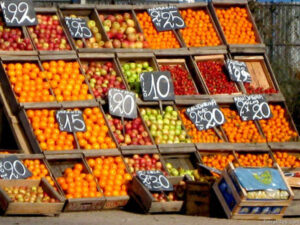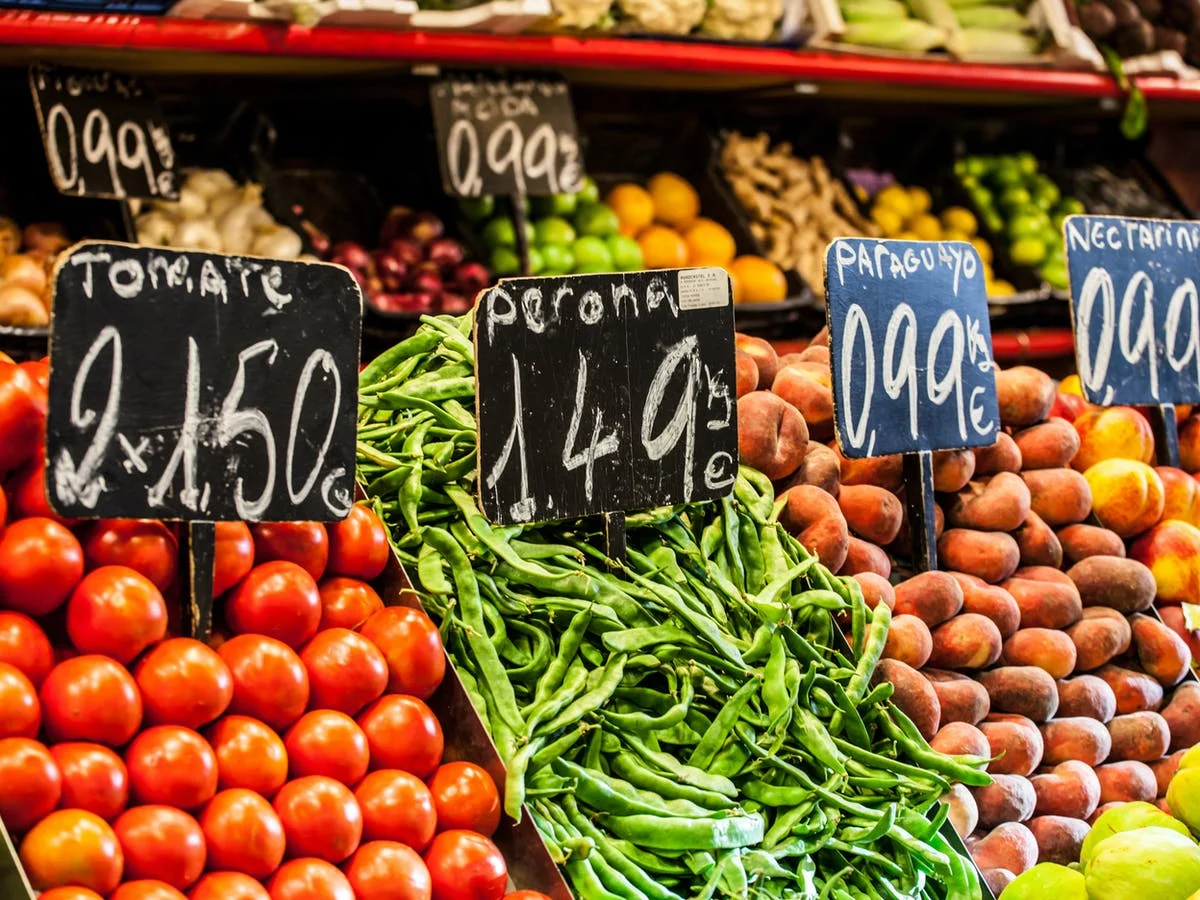https://finanzasdomesticas.com/los-precios-de-los-alimentos/ are important to everyone because they affect how much we pay for the food we buy. Knowing about los precios de los alimentos can help us make better choices at the store.
When los precios de los alimentos go up, it means we might need to spend more money on groceries. It’s helpful to understand why this happens and how we can manage our budgets better.
What Are Los Precios de los Alimentos
Los precios de los alimentos are the prices you pay when you buy food. These prices can be different depending on where you live. In some places, los precios de los alimentos might be high, while in other places, they might be lower.
When you go to the grocery store, you can see los precios de los alimentos on the labels of each item. These prices help you decide what you want to buy. If los precios de los alimentos go up, you might need to choose different items or buy less.
Understanding los precios de los alimentos can help you plan your shopping better. It’s important to check these prices regularly to make sure you are getting good deals.
How Los Precios de los Alimentos Affect Your Budget
Los precios de los alimentos can have a big impact on your budget. When these prices increase, you might find that you have less money to spend on other things. This can make it harder to save money or buy things you want.
To manage your budget well, keep track of how los precios de los alimentos change. If you notice that these prices are going up, you might need to adjust your spending in other areas. This way, you can still buy the food you need without going over your budget.
Planning ahead can help you handle changes in los precios de los alimentos. Try to make a shopping list and stick to it. This can help you avoid buying things you don’t need and keep your budget on track.
Why Los Precios de los Alimentos Change
Los precios de los alimentos change for many reasons. Sometimes, these changes are due to weather conditions, like droughts or floods, which can affect crop production. Other times, it might be because of changes in supply and demand.
When there is less food available, los precios de los alimentos can go up. On the other hand, if there is a lot of food, prices might go down. Understanding these reasons can help you prepare for price changes.
Tracking how los precios de los alimentos change over time can give you a better idea of when to buy certain items. This way, you can try to buy things when the prices are lower.
How to Save Money When Los Precios de los Alimentos Go Up
When los precios de los alimentos go up, it’s important to find ways to save money. One way to do this is by buying in bulk. Items bought in large quantities often cost less per unit than smaller packages.
Another tip is to use coupons or take advantage of sales. Many stores offer discounts or special deals that can help you save money on groceries. Keep an eye out for these opportunities to stretch your budget further.
Planning your meals in advance can also help you save money. By knowing what you need to buy ahead of time, you can avoid impulse purchases and stick to your budget.
Comparing Los Precios de los Alimentos in Different Stores
Comparing los precios de los alimentos in different stores is a smart way to save money. Prices can vary from one store to another, so it’s worth checking several places before you shop.
You can use apps or websites to compare prices easily. Many of these tools allow you to see which store offers the best deals on the items you need. By comparing, you can make sure you are getting the best prices available.
Remember that the cheapest option is not always the best. Sometimes, buying from a store that offers good quality can be a better choice, even if the prices are slightly higher.

The Impact of Los Precios de los Alimentos on Families
Los precios de los alimentos can affect families in many ways. Higher prices can mean that families have to cut back on other expenses or choose cheaper food options. This can be especially challenging for families with limited budgets.
To handle these changes, families might need to adjust their shopping habits. Making a budget and sticking to it can help manage the impact of rising prices. Planning meals and buying in bulk can also help reduce overall costs.
It’s important to find ways to keep food costs manageable while still providing nutritious options for everyone in the family. This can help ensure that all family members are getting the food they need.
Tips for Shopping Smart with Los Precios de los Alimentos
Shopping smart with los precios de los alimentos involves several strategies. First, making a shopping list can help you stay focused and avoid buying things you don’t need.
Second, consider buying generic or store brands. These often cost less than name brands but offer similar quality. Another tip is to use loyalty cards or rewards programs at stores to save even more.
Also, keep an eye on seasonal produce. Fruits and vegetables that are in season usually cost less and taste better. This can be a great way to save money while enjoying fresh food.
How to Track Los Precios de los Alimentos Over Time
Tracking los precios de los alimentos over time can help you see patterns and plan your shopping better. Start by noting down the prices of items you buy regularly.
You can use a notebook or an app to keep track of these prices. Over time, you might notice that some prices go up or down in a regular pattern. This information can help you decide the best times to buy certain items.
By tracking these changes, you can better manage your budget and make informed shopping decisions.
Understanding the Factors Behind Los Precios de los Alimentos
Many factors affect los precios de los alimentos. These include the cost of production, transportation, and labor. Changes in any of these areas can lead to changes in food prices.
For example, if fuel prices go up, the cost to transport food can also increase. This might cause los precios de los alimentos to rise. Similarly, if there are issues with farming, such as bad weather, it can also affect food prices.
Understanding these factors can help you better anticipate changes in prices and plan your shopping accordingly.
How to Find Deals Despite Los Precios de los Alimentos
Finding deals despite rising los precios de los alimentos is possible with a few smart strategies. Start by looking for store promotions and discounts. Many stores offer sales on certain items each week.
Using coupons is another great way to save money. Check newspapers or online coupon sites for offers that can help reduce your grocery bill.
Also, consider joining store loyalty programs. These often provide additional discounts and special offers that can help you save money on your shopping.
Los Precios de los Alimentos and Seasonal Changes
Los precios de los alimentos can change with the seasons. Fruits and vegetables that are in season are often cheaper and fresher. For example, strawberries might be less expensive in summer when they are in season.
By buying seasonal produce, you can save money and enjoy better-tasting food. Plan your meals around what is currently in season to get the best deals.
Also, be aware of holiday seasons or special events, as these can sometimes affect food prices. Planning ahead can help you avoid higher costs during these times.
How Los Precios de los Alimentos Affect Your Favorite Foods
Los precios de los alimentos can affect your favorite foods in many ways. If the prices of ingredients go up, the cost of making your favorite meals can also increase.
Sometimes, you might need to make adjustments to your recipes or choose different brands to keep costs down. It’s also a good idea to look for alternatives or substitutions that can help you stay within your budget.
Finding ways to enjoy your favorite foods without spending too much can make a big difference in managing your grocery expenses.
How to Budget for Changes in Los Precios de los Alimentos
When los precios de los alimentos start to rise, it’s important to adjust your budget accordingly. Begin by reviewing your current spending on groceries and identifying areas where you can cut back. For instance, you might find that you spend a lot on snacks or convenience items that could be reduced or replaced with more affordable options.
Creating a monthly food budget can help you manage these changes better. Track your expenses each week and compare them to your budget. This way, you’ll be able to see if you’re staying on track or if you need to make adjustments. You might also want to set aside a small buffer amount in your budget to cover unexpected price increases.
Additionally, try to plan meals and shop with a list. This helps avoid impulse purchases and ensures that you’re buying only what you need. By making these changes, you can better manage your budget and deal with the impact of rising food prices.
The Role of Supply and Demand in Los Precios de los Alimentos
Supply and demand play a big role in los precios de los alimentos. When there is a high demand for a certain food but not enough supply, prices tend to go up. For example, if a popular fruit is in short supply because of weather problems, the price might increase.
Conversely, if there is a large supply of a food item and not as much demand, prices can go down. This is why you might see sales on certain items when there is an abundance of them.
Understanding supply and demand can help you make smarter shopping decisions. If you know that certain foods are in high demand or short supply, you can plan your purchases accordingly. This can help you save money and get the best deals on the food you need.
How Los Precios de los Alimentos Impact Different Types of Stores
Los precios de los alimentos can vary between different types of stores. For example, grocery stores, discount stores, and specialty stores often have different pricing strategies. Grocery stores might have higher prices, but they often offer a wider variety of products. Discount stores may offer lower prices but might not have as many choices.
Specialty stores, which focus on specific types of foods, can sometimes be more expensive. However, they might have unique items that aren’t available elsewhere. Comparing prices across these different types of stores can help you find the best deals for your needs.
Knowing the strengths of each type of store can help you decide where to shop. For everyday items, a discount store might be the best choice, while for special products, a specialty store might offer what you need.
The Impact of Global Events on Los Precios de los Alimentos
Global events can significantly impact los precios de los alimentos. For example, natural disasters, political unrest, or economic changes in other countries can affect food prices around the world. If a major crop-producing country experiences a drought, it can lead to higher prices for certain foods.
Economic changes, like inflation or trade policies, can also influence food prices. If trade agreements change, it might affect the cost of importing or exporting food, leading to price fluctuations.
Keeping an eye on global news can help you understand these factors. By being aware of potential impacts, you can better plan your shopping and budget for any changes in los precios de los alimentos.

How to Make the Most of Sales and Discounts with Los Precios de los Alimentos
Sales and discounts can help you manage los precios de los alimentos better. To make the most of these opportunities, keep an eye out for store promotions and special offers. Many stores have weekly sales that can significantly reduce the cost of groceries.
Using coupons is another effective way to save money. Collect coupons from newspapers, online sites, or store apps to get discounts on the items you buy regularly.
Additionally, consider joining store loyalty programs. These programs often provide exclusive discounts and rewards that can help you save more. Planning your shopping around sales and using coupons can help you get the most value for your money.
The Effects of Seasonal Variations on Los Precios de los Alimentos
Seasonal variations can affect los precios de los alimentos. Foods that are in season are usually cheaper and fresher. For example, you might find that fruits and vegetables are less expensive in their peak season.
When foods are out of season, they can be more expensive because they need to be imported from other regions or grown in controlled environments. This can increase the cost of these items.
By buying seasonal produce, you can save money and enjoy better-tasting food. Planning your meals around what is currently in season can help you get the best prices and quality.
Understanding How Los Precios de los Alimentos Affect Different Meal Plans
Los precios de los alimentos can impact your meal plans. If food prices rise, you might need to adjust your meal plans to fit your budget. This could mean choosing less expensive ingredients or finding new recipes that use affordable items.
One way to manage this is by planning meals that use versatile ingredients. For example, beans, rice, and pasta are often affordable and can be used in various dishes.
Another approach is to cook in bulk and freeze meals for later. This can help you save money by buying in larger quantities and reducing the need for frequent grocery trips.
Tips for Buying Fresh Produce When Los Precios de los Alimentos Are High
Buying fresh produce can be challenging when los precios de los alimentos are high. To get the best deals, try shopping at local farmers’ markets. These markets often offer fresh produce at lower prices than grocery stores.
Another tip is to buy fruits and vegetables that are in season. Seasonal produce is usually cheaper and tastes better. You can also consider buying frozen fruits and vegetables, which can be less expensive and have a longer shelf life.
Planning meals around these tips can help you get the most value from your grocery budget while still enjoying fresh and healthy foods.
How to Use Meal Planning to Handle Los Precios de los Alimentos
Meal planning can be a useful tool for managing los precios de los alimentos. By planning your meals ahead of time, you can make more efficient use of the food you buy.
Start by creating a weekly meal plan and shopping list based on what you already have and what’s on sale. This helps you avoid buying items you don’t need and reduces food waste.
Using meal planning also allows you to take advantage of bulk buying. Purchasing staples like grains and canned goods in larger quantities can save money over time and ensure you always have essential ingredients on hand.
How Los Precios de los Alimentos Affect Special Diets
Los precios de los alimentos can affect special diets, such as gluten-free or organic diets. Foods that cater to these diets often cost more than regular options. If you follow a special diet, you might need to be more mindful of how you spend on groceries.
To manage these costs, look for discounts and deals specifically for special diet products. Some stores offer discounts on specialty items, or you might find lower prices online.
Planning meals and buying in bulk can also help. For instance, buying gluten-free grains or organic products in larger quantities can sometimes be more cost-effective.
The Relationship Between Los Precios de los Alimentos and Local Economy
Los precios de los alimentos are closely related to the local economy. When the local economy is strong, people have more money to spend, which can drive up food prices. Conversely, in a weaker economy, demand for food might decrease, leading to lower prices.
Understanding this relationship can help you anticipate changes in food prices. If you know that the local economy is experiencing changes, you can plan your budget and shopping accordingly.
Staying informed about local economic conditions can provide insights into how los precios de los alimentos might fluctuate and help you manage your finances better.
Conclusion
Understanding los precios de los alimentos helps you make better choices when shopping for food. By keeping track of prices and looking for deals, you can manage your budget more effectively. It’s important to be aware of how food prices change and plan your meals around these changes.
Remember, you can save money by comparing prices, buying in bulk, and using coupons. Keeping an eye on seasonal produce and exploring alternative foods can also help you get the most value for your money. With these tips, you can handle rising food prices and enjoy your meals without breaking the bank!



